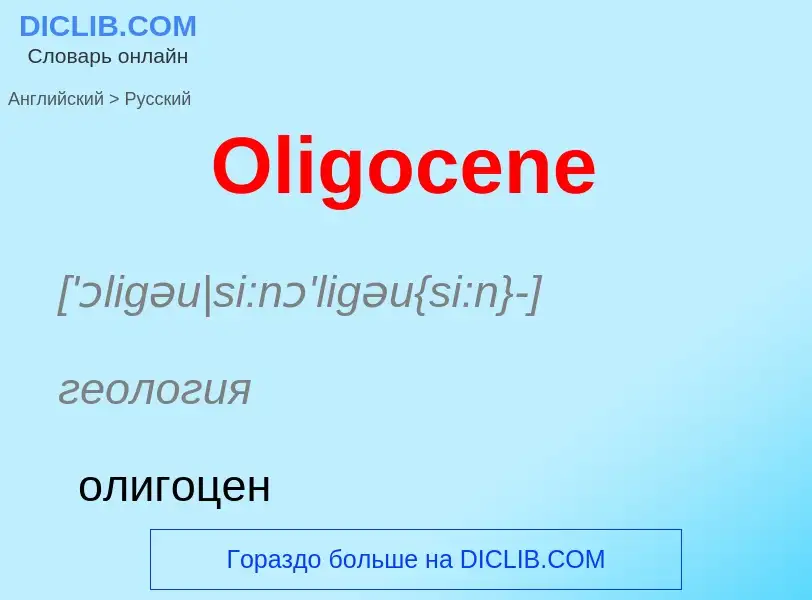Tradução e análise de palavras por inteligência artificial ChatGPT
Nesta página você pode obter uma análise detalhada de uma palavra ou frase, produzida usando a melhor tecnologia de inteligência artificial até o momento:
- como a palavra é usada
- frequência de uso
- é usado com mais frequência na fala oral ou escrita
- opções de tradução de palavras
- exemplos de uso (várias frases com tradução)
- etimologia
Oligocene - tradução para russo
['ɔligəu|si:nɔ'ligəu{si:n}-]
геология
олигоцен
существительное
геология
олигоцен
общая лексика
латторфский
Definição
Wikipédia
The Oligocene (IPA: OL-ə-gə-seen, -goh-) is a geologic epoch of the Paleogene Period and extends from about 33.9 million to 23 million years before the present (33.9±0.1 to 23.03±0.05 Ma). As with other older geologic periods, the rock beds that define the epoch are well identified but the exact dates of the start and end of the epoch are slightly uncertain. The name Oligocene was coined in 1854 by the German paleontologist Heinrich Ernst Beyrich from his studies of marine beds in Belgium and Germany. The name comes from the Ancient Greek ὀλίγος (olígos, "few") and καινός (kainós, "new"), and refers to the sparsity of extant forms of molluscs. The Oligocene is preceded by the Eocene Epoch and is followed by the Miocene Epoch. The Oligocene is the third and final epoch of the Paleogene Period.
The Oligocene is often considered an important time of transition, a link between the archaic world of the tropical Eocene and the more modern ecosystems of the Miocene. Major changes during the Oligocene included a global expansion of grasslands, and a regression of tropical broad leaf forests to the equatorial belt.
The start of the Oligocene is marked by a notable extinction event called the Grande Coupure; it featured the replacement of European fauna with Asian fauna, except for the endemic rodent and marsupial families. By contrast, the Oligocene–Miocene boundary is not set at an easily identified worldwide event but rather at regional boundaries between the warmer late Oligocene and the relatively cooler Miocene.

![Life restoration of ''[[Daeodon]]'' Life restoration of ''[[Daeodon]]''](https://commons.wikimedia.org/wiki/Special:FilePath/Daeodon shoshonensis 2.png?width=200)
![[[Neotethys]] during the Oligocene (Rupelian, 33.9–28.4 mya) [[Neotethys]] during the Oligocene (Rupelian, 33.9–28.4 mya)](https://commons.wikimedia.org/wiki/Special:FilePath/Mediterranean Rupelian.jpg?width=200)

![Reconstruction of ''[[Aglaocetus]] moreni'' Reconstruction of ''[[Aglaocetus]] moreni''](https://commons.wikimedia.org/wiki/Special:FilePath/Reconstruction of Aglaocetus moreni (fossil baleen whale) (Oligocene; Argentina) (32313481396).jpg?width=200)
![Restoration of ''[[Nimravus]]'' (far left) and other animals from the [[Turtle Cove Formation]] Restoration of ''[[Nimravus]]'' (far left) and other animals from the [[Turtle Cove Formation]]](https://commons.wikimedia.org/wiki/Special:FilePath/Turtle Cove mural - Roger Witter.jpg?width=200)
![[[Poebrotherium]] [[Poebrotherium]]](https://commons.wikimedia.org/wiki/Special:FilePath/NMNH-USNMV15917Poebrotherium.jpg?width=200)
![[[Merycoidodon]] [[Merycoidodon]]](https://commons.wikimedia.org/wiki/Special:FilePath/Merycoidodon Skull Oligocene Left Side.jpg?width=200)
![[[Hoplophoneus]] [[Hoplophoneus]]](https://commons.wikimedia.org/wiki/Special:FilePath/Hoplophoneus primaevus (fossil false sabertooth cat) (Middle Oligocene; Nebraska, USA) 3 (32791323412).jpg?width=200)
![[[Mesohippus]] [[Mesohippus]]](https://commons.wikimedia.org/wiki/Special:FilePath/Mesohippus barbouri Harvard.jpg?width=200)
![[[Paraceratherium]] [[Paraceratherium]]](https://commons.wikimedia.org/wiki/Special:FilePath/Paraceratherium transouralicum skull.jpg?width=200)
![[[Paleoparadoxia]] [[Paleoparadoxia]]](https://commons.wikimedia.org/wiki/Special:FilePath/Paleoparadoxia Natural History Museum of Los Angeles County 20110330.jpg?width=200)
![[[Protoceras]] [[Protoceras]]](https://commons.wikimedia.org/wiki/Special:FilePath/Protoceras skeleton.jpg?width=200)
![[[Janjucetus]] [[Janjucetus]]](https://commons.wikimedia.org/wiki/Special:FilePath/Janjucetus hunderi skull.jpg?width=200)
